KIA Sorento 2006 1.G Owner's Manual
Manufacturer: KIA, Model Year: 2006, Model line: Sorento, Model: KIA Sorento 2006 1.GPages: 312, PDF Size: 5.21 MB
Page 121 of 312
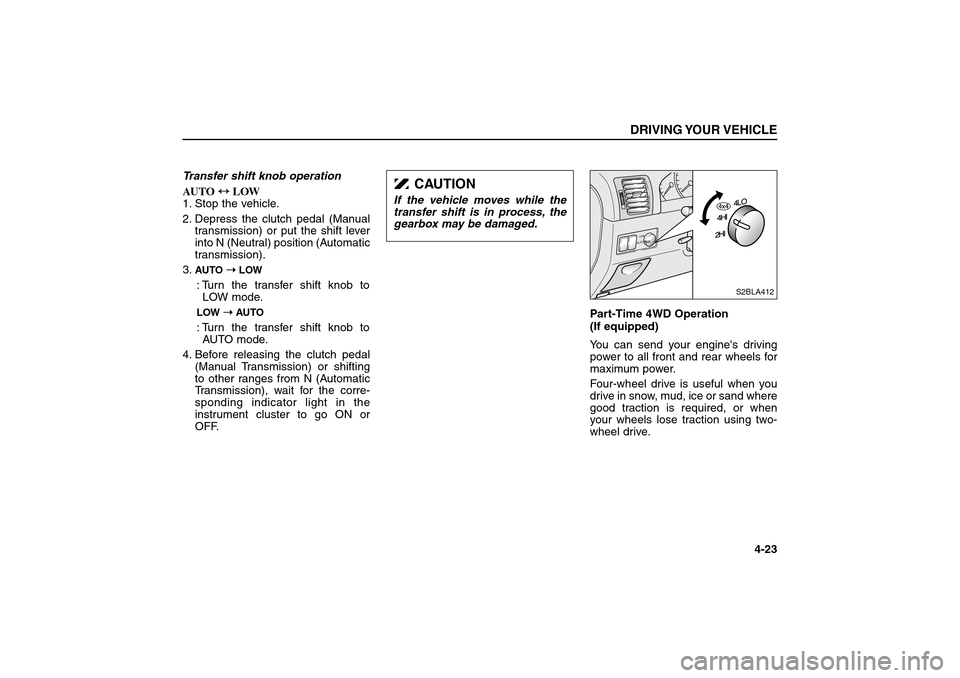
Transfer shift knob operation
AUTO ↔ ↔
LOW
1. Stop the vehicle.
2. Depress the clutch pedal (Manual
transmission) or put the shift lever
into N (Neutral) position (Automatic
transmission).
3.
AUTO ➝ ➝
LOW: Turn the transfer shift knob to
LOW mode.LOW ➝ ➝
AUTO: Turn the transfer shift knob to
AUTO mode.
4. Before releasing the clutch pedal
(Manual Transmission) or shifting
to other ranges from N (Automatic
Transmission), wait for the corre-
sponding indicator light in the
instrument cluster to go ON or
OFF.Part-Time 4WD Operation
(If equipped)
You can send your engine's driving
power to all front and rear wheels for
maximum power.
Four-wheel drive is useful when you
drive in snow, mud, ice or sand where
good traction is required, or when
your wheels lose traction using two-
wheel drive.
DRIVING YOUR VEHICLE
4-23
L
O
WAUTO
S2BLA412
CAUTION
If the vehicle moves while the
transfer shift is in process, the
gearbox may be damaged.
BL-ENG (CAN)-4.qxd 7/28/05 5:55 PM Page 23
Page 122 of 312
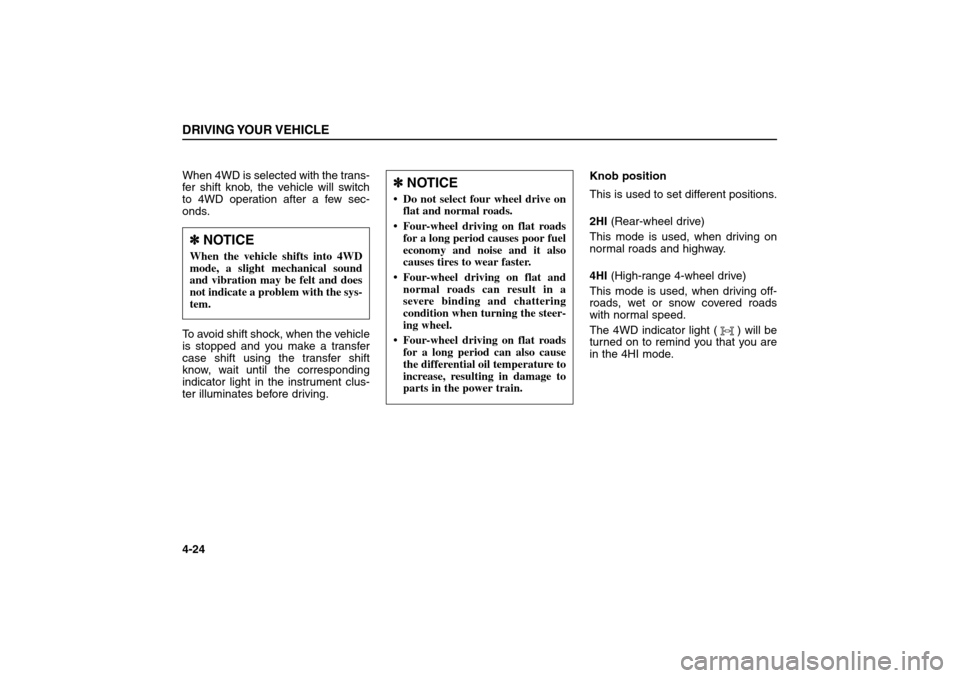
When 4WD is selected with the trans-
fer shift knob, the vehicle will switch
to 4WD operation after a few sec-
onds.
To avoid shift shock, when the vehicle
is stopped and you make a transfer
case shift using the transfer shift
know, wait until the corresponding
indicator light in the instrument clus-
ter illuminates before driving.Knob position
This is used to set different positions.
2HI(Rear-wheel drive)
This mode is used, when driving on
normal roads and highway.
4HI(High-range 4-wheel drive)
This mode is used, when driving off-
roads, wet or snow covered roads
with normal speed.
The 4WD indicator light ( ) will be
turned on to remind you that you are
in the 4HI mode.DRIVING YOUR VEHICLE4-24
✽ ✽
NOTICE Do not select four wheel drive on
flat and normal roads.
Four-wheel driving on flat roads
for a long period causes poor fuel
economy and noise and it also
causes tires to wear faster.
Four-wheel driving on flat and
normal roads can result in a
severe binding and chattering
condition when turning the steer-
ing wheel.
Four-wheel driving on flat roads
for a long period can also cause
the differential oil temperature to
increase, resulting in damage to
parts in the power train.
✽ ✽
NOTICEWhen the vehicle shifts into 4WD
mode, a slight mechanical sound
and vibration may be felt and does
not indicate a problem with the sys-
tem.
BL-ENG (CAN)-4.qxd 7/28/05 5:55 PM Page 24
Page 123 of 312
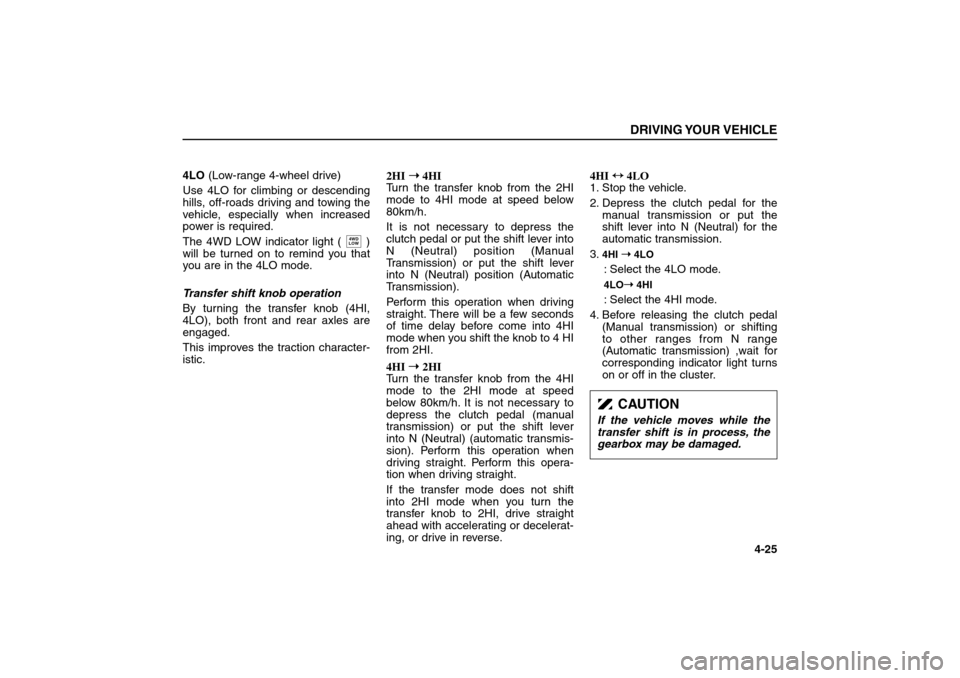
4LO(Low-range 4-wheel drive)
Use 4LO for climbing or descending
hills, off-roads driving and towing the
vehicle, especially when increased
power is required.
The 4WD LOW indicator light ( )
will be turned on to remind you that
you are in the 4LO mode.
Transfer shift knob operation
By turning the transfer knob (4HI,
4LO), both front and rear axles are
engaged.
This improves the traction character-
istic.2HI➝ ➝
4HI
Turn the transfer knob from the 2HI
mode to 4HI mode at speed below
80km/h.
It is not necessary to depress the
clutch pedal or put the shift lever into
N (Neutral) position (Manual
Transmission) or put the shift lever
into N (Neutral) position (Automatic
Transmission).
Perform this operation when driving
straight. There will be a few seconds
of time delay before come into 4HI
mode when you shift the knob to 4 HI
from 2HI.
4HI ➝ ➝
2HI
Turn the transfer knob from the 4HI
mode to the 2HI mode at speed
below 80km/h. It is not necessary to
depress the clutch pedal (manual
transmission) or put the shift lever
into N (Neutral) (automatic transmis-
sion). Perform this operation when
driving straight. Perform this opera-
tion when driving straight.
If the transfer mode does not shift
into 2HI mode when you turn the
transfer knob to 2HI, drive straight
ahead with accelerating or decelerat-
ing, or drive in reverse.4HI ↔ ↔
4LO
1. Stop the vehicle.
2. Depress the clutch pedal for the
manual transmission or put the
shift lever into N (Neutral) for the
automatic transmission.
3.
4HI ➝ ➝
4LO: Select the 4LO mode.4LO➝ ➝
4HI: Select the 4HI mode.
4. Before releasing the clutch pedal
(Manual transmission) or shifting
to other ranges from N range
(Automatic transmission) ,wait for
corresponding indicator light turns
on or off in the cluster.
4WD
LOW
DRIVING YOUR VEHICLE
4-25
CAUTION
If the vehicle moves while the
transfer shift is in process, the
gearbox may be damaged.
BL-ENG (CAN)-4.qxd 7/28/05 5:55 PM Page 25
Page 124 of 312
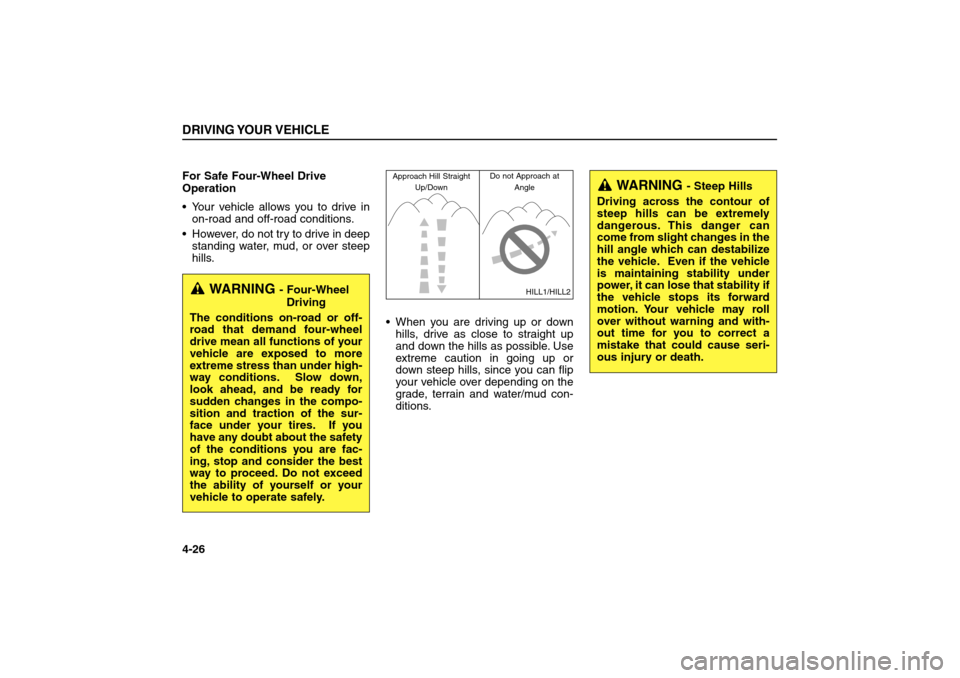
For Safe Four-Wheel Drive
Operation
Your vehicle allows you to drive in
on-road and off-road conditions.
However, do not try to drive in deep
standing water, mud, or over steep
hills.
When you are driving up or down
hills, drive as close to straight up
and down the hills as possible. Use
extreme caution in going up or
down steep hills, since you can flip
your vehicle over depending on the
grade, terrain and water/mud con-
ditions.DRIVING YOUR VEHICLE4-26
WARNING
- Four-Wheel
Driving
The conditions on-road or off-
road that demand four-wheel
drive mean all functions of your
vehicle are exposed to more
extreme stress than under high-
way conditions. Slow down,
look ahead, and be ready for
sudden changes in the compo-
sition and traction of the sur-
face under your tires. If you
have any doubt about the safety
of the conditions you are fac-
ing, stop and consider the best
way to proceed. Do not exceed
the ability of yourself or your
vehicle to operate safely.
WARNING
- Steep Hills
Driving across the contour of
steep hills can be extremely
dangerous. This danger can
come from slight changes in the
hill angle which can destabilize
the vehicle. Even if the vehicle
is maintaining stability under
power, it can lose that stability if
the vehicle stops its forward
motion. Your vehicle may roll
over without warning and with-
out time for you to correct a
mistake that could cause seri-
ous injury or death.
HILL1/HILL2 Approach Hill Straight
Up/DownDo not Approach at
Angle
BL-ENG (CAN)-4.qxd 7/28/05 5:55 PM Page 26
Page 125 of 312
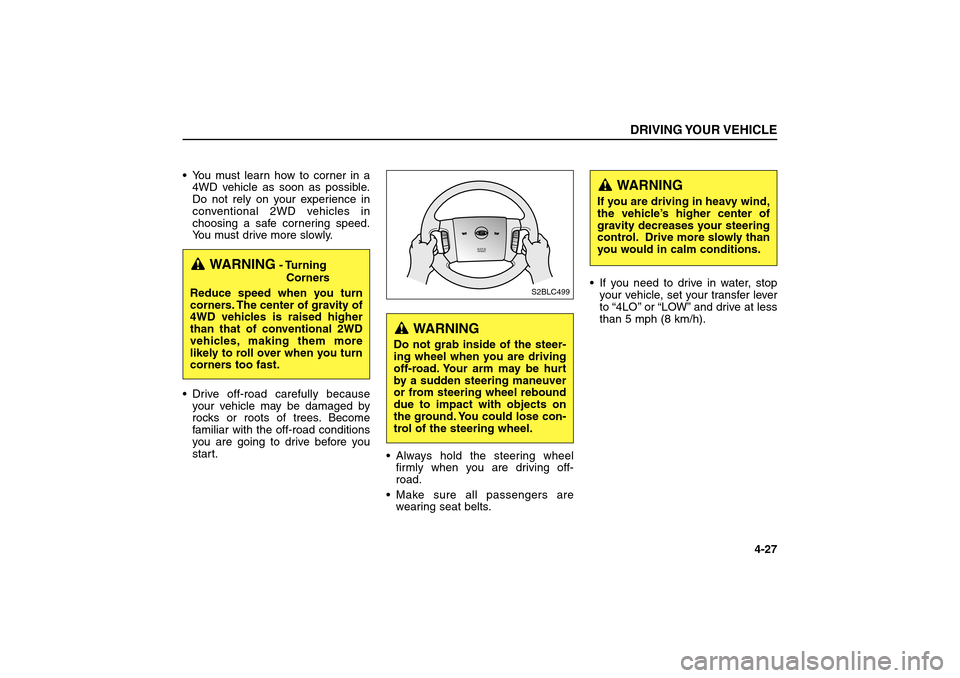
You must learn how to corner in a
4WD vehicle as soon as possible.
Do not rely on your experience in
conventional 2WD vehicles in
choosing a safe cornering speed.
You must drive more slowly.
Drive off-road carefully because
your vehicle may be damaged by
rocks or roots of trees. Become
familiar with the off-road conditions
you are going to drive before you
start.
Always hold the steering wheel
firmly when you are driving off-
road.
Make sure all passengers are
wearing seat belts.If you need to drive in water, stop
your vehicle, set your transfer lever
to “4LO’’or “LOW”and drive at less
than 5 mph (8 km/h).
DRIVING YOUR VEHICLE
4-27
WARNING
- Turning
Corners
Reduce speed when you turn
corners. The center of gravity of
4WD vehicles is raised higher
than that of conventional 2WD
vehicles, making them more
likely to roll over when you turn
corners too fast.
WARNING
Do not grab inside of the steer-
ing wheel when you are driving
off-road. Your arm may be hurt
by a sudden steering maneuver
or from steering wheel rebound
due to impact with objects on
the ground. You could lose con-
trol of the steering wheel.
WARNING
If you are driving in heavy wind,
the vehicle’s higher center of
gravity decreases your steering
control. Drive more slowly than
you would in calm conditions.
SRSAIRBAG
R
E
S
A
C
C
E
LC
O
A
S
T
S
E
T
PWRSEEK
CANCEL
S2BLC499
BL-ENG (CAN)-4.qxd 7/28/05 5:55 PM Page 27
Page 126 of 312
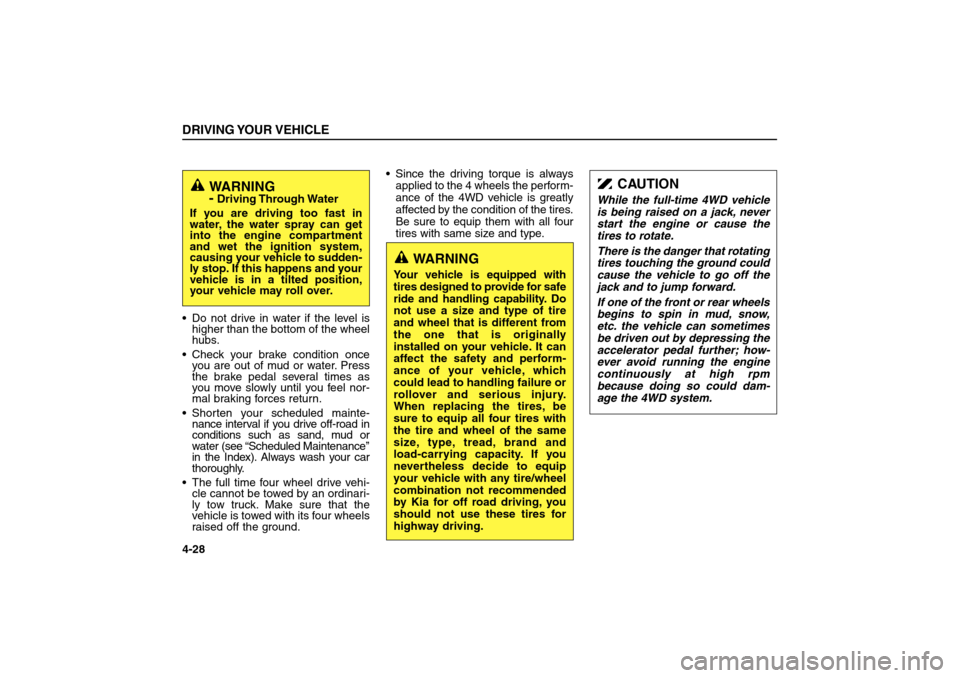
Do not drive in water if the level is
higher than the bottom of the wheel
hubs.
Check your brake condition once
you are out of mud or water. Press
the brake pedal several times as
you move slowly until you feel nor-
mal braking forces return.
Shorten your scheduled mainte-
nance interval if you drive off-road in
conditions such as sand, mud or
water (see “Scheduled Maintenance’’
in the Index). Always wash your car
thoroughly.
The full time four wheel drive vehi-
cle cannot be towed by an ordinari-
ly tow truck. Make sure that the
vehicle is towed with its four wheels
raised off the ground.Since the driving torque is always
applied to the 4 wheels the perform-
ance of the 4WD vehicle is greatly
affected by the condition of the tires.
Be sure to equip them with all four
tires with same size and type.DRIVING YOUR VEHICLE4-28
CAUTION
While the full-time 4WD vehicle
is being raised on a jack, never
start the engine or cause the
tires to rotate.
There is the danger that rotating
tires touching the ground could
cause the vehicle to go off the
jack and to jump forward.
If one of the front or rear wheels
begins to spin in mud, snow,
etc. the vehicle can sometimes
be driven out by depressing the
accelerator pedal further; how-
ever avoid running the engine
continuously at high rpm
because doing so could dam-
age the 4WD system.
WARNING
-Driving Through Water
If you are driving too fast in
water, the water spray can get
into the engine compartment
and wet the ignition system,
causing your vehicle to sudden-
ly stop. If this happens and your
vehicle is in a tilted position,
your vehicle may roll over.
WARNING
Your vehicle is equipped with
tires designed to provide for safe
ride and handling capability. Do
not use a size and type of tire
and wheel that is different from
the one that is originally
installed on your vehicle. It can
affect the safety and perform-
ance of your vehicle, which
could lead to handling failure or
rollover and serious injury.
When replacing the tires, be
sure to equip all four tires with
the tire and wheel of the same
size, type, tread, brand and
load-carrying capacity. If you
nevertheless decide to equip
your vehicle with any tire/wheel
combination not recommended
by Kia for off road driving, you
should not use these tires for
highway driving.
BL-ENG (CAN)-4.qxd 7/28/05 5:55 PM Page 28
Page 127 of 312
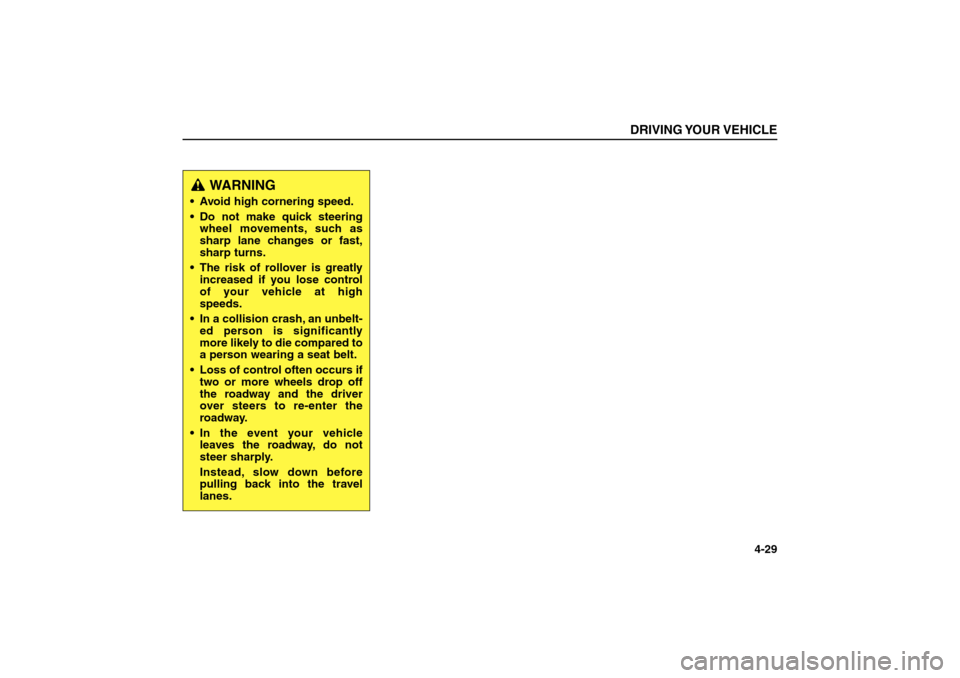
DRIVING YOUR VEHICLE
4-29
WARNING
Avoid high cornering speed.
Do not make quick steering
wheel movements, such as
sharp lane changes or fast,
sharp turns.
The risk of rollover is greatly
increased if you lose control
of your vehicle at high
speeds.
In a collision crash, an unbelt-
ed person is significantly
more likely to die compared to
a person wearing a seat belt.
Loss of control often occurs if
two or more wheels drop off
the roadway and the driver
over steers to re-enter the
roadway.
In the event your vehicle
leaves the roadway, do not
steer sharply.
Instead, slow down before
pulling back into the travel
lanes.
BL-ENG (CAN)-4.qxd 7/28/05 5:55 PM Page 29
Page 128 of 312
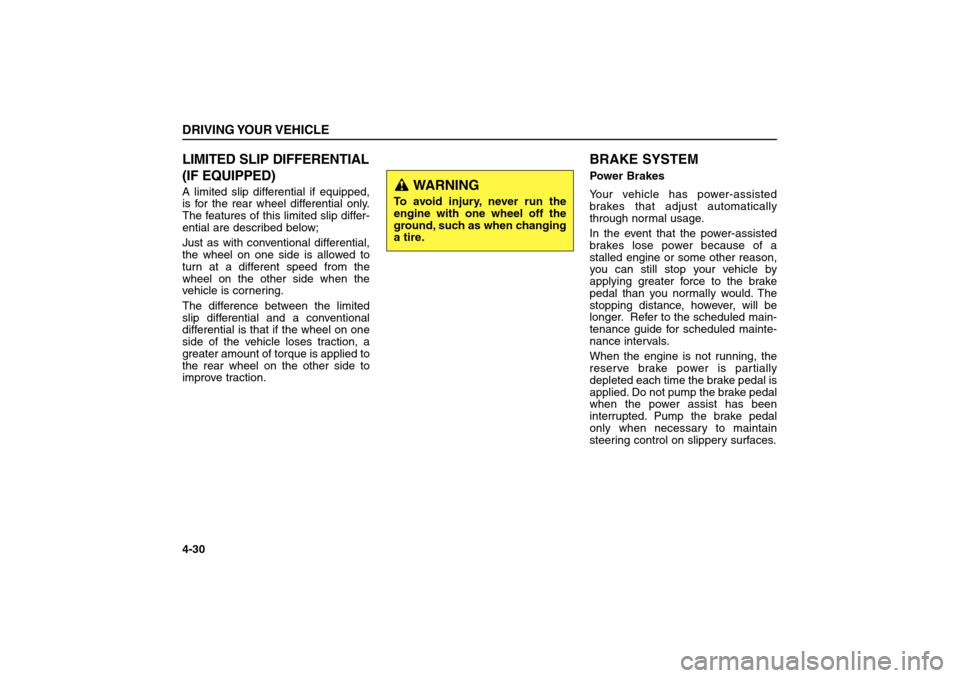
LIMITED SLIP DIFFERENTIAL
(IF EQUIPPED) A limited slip differential if equipped,
is for the rear wheel differential only.
The features of this limited slip differ-
ential are described below;
Just as with conventional differential,
the wheel on one side is allowed to
turn at a different speed from the
wheel on the other side when the
vehicle is cornering.
The difference between the limited
slip differential and a conventional
differential is that if the wheel on one
side of the vehicle loses traction, a
greater amount of torque is applied to
the rear wheel on the other side to
improve traction.
BRAKE SYSTEMPower Brakes
Your vehicle has power-assisted
brakes that adjust automatically
through normal usage.
In the event that the power-assisted
brakes lose power because of a
stalled engine or some other reason,
you can still stop your vehicle by
applying greater force to the brake
pedal than you normally would. The
stopping distance, however, will be
longer. Refer to the scheduled main-
tenance guide for scheduled mainte-
nance intervals.
When the engine is not running, the
reserve brake power is partially
depleted each time the brake pedal is
applied. Do not pump the brake pedal
when the power assist has been
interrupted. Pump the brake pedal
only when necessary to maintain
steering control on slippery surfaces.
DRIVING YOUR VEHICLE4-30
WARNING
To avoid injury, never run the
engine with one wheel off the
ground, such as when changing
a tire.
BL-ENG (CAN)-4.qxd 7/28/05 5:55 PM Page 30
Page 129 of 312
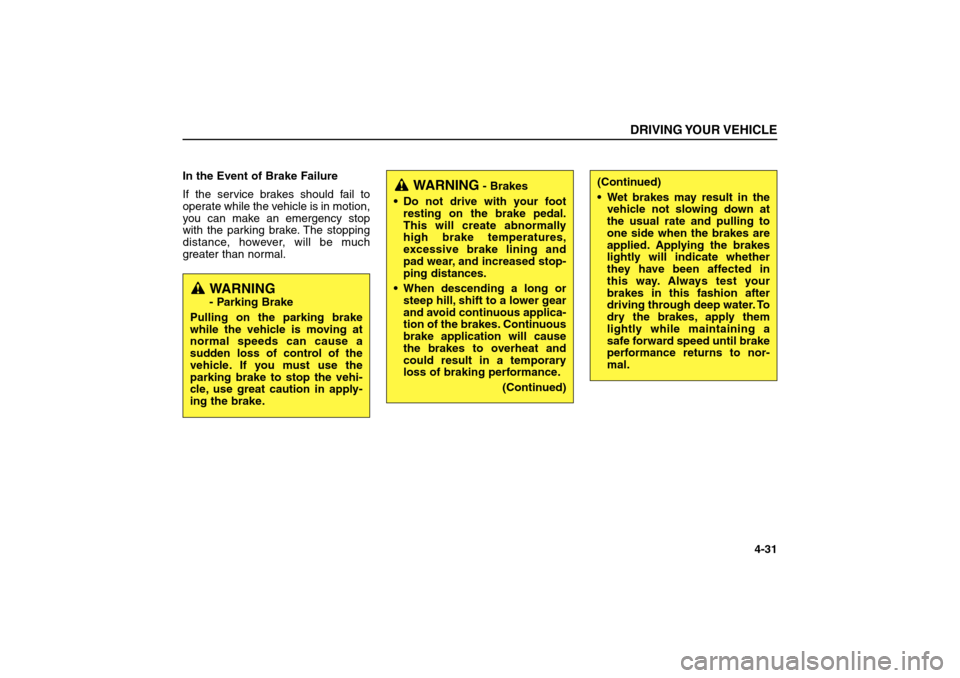
In the Event of Brake Failure
If the service brakes should fail to
operate while the vehicle is in motion,
you can make an emergency stop
with the parking brake. The stopping
distance, however, will be much
greater than normal.
DRIVING YOUR VEHICLE
4-31
WARNING- Parking Brake
Pulling on the parking brake
while the vehicle is moving at
normal speeds can cause a
sudden loss of control of the
vehicle. If you must use the
parking brake to stop the vehi-
cle, use great caution in apply-
ing the brake.
WARNING
- Brakes
Do not drive with your foot
resting on the brake pedal.
This will create abnormally
high brake temperatures,
excessive brake lining and
pad wear, and increased stop-
ping distances.
When descending a long or
steep hill, shift to a lower gear
and avoid continuous applica-
tion of the brakes. Continuous
brake application will cause
the brakes to overheat and
could result in a temporary
loss of braking performance.
(Continued)
(Continued)
Wet brakes may result in the
vehicle not slowing down at
the usual rate and pulling to
one side when the brakes are
applied. Applying the brakes
lightly will indicate whether
they have been affected in
this way. Always test your
brakes in this fashion after
driving through deep water. To
dry the brakes, apply them
lightly while maintaining a
safe forward speed until brake
performance returns to nor-
mal.
BL-ENG (CAN)-4.qxd 7/28/05 5:55 PM Page 31
Page 130 of 312
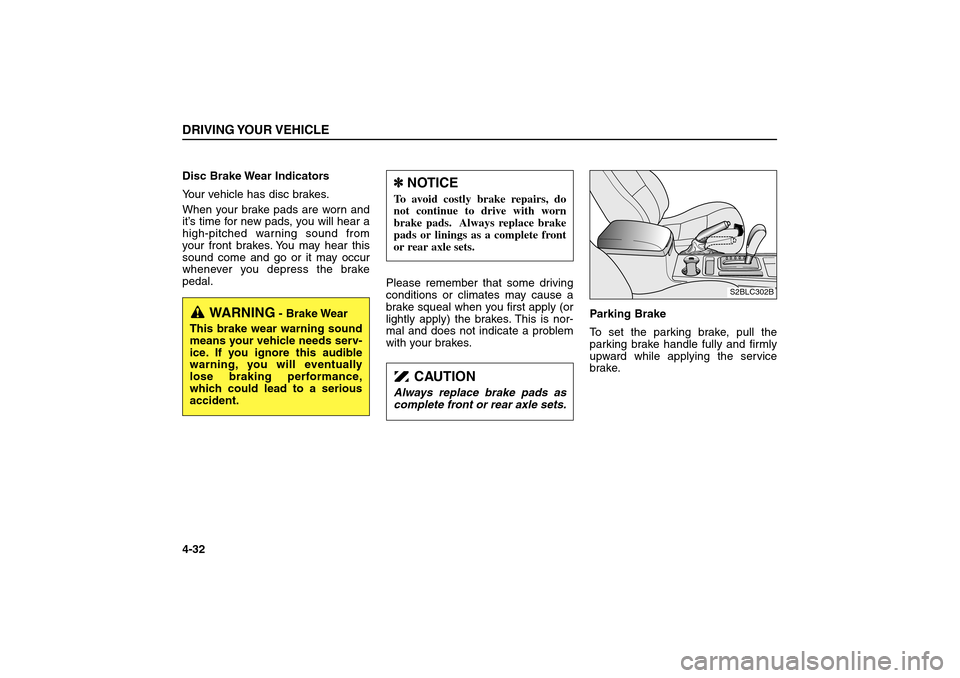
Disc Brake Wear Indicators
Your vehicle has disc brakes.
When your brake pads are worn and
it’s time for new pads, you will hear a
high-pitched warning sound from
your front brakes. You may hear this
sound come and go or it may occur
whenever you depress the brake
pedal.
Please remember that some driving
conditions or climates may cause a
brake squeal when you first apply (or
lightly apply) the brakes. This is nor-
mal and does not indicate a problem
with your brakes.Parking Brake
To set the parking brake, pull the
parking brake handle fully and firmly
upward while applying the service
brake.DRIVING YOUR VEHICLE4-32
S2BLC302B
WARNING
- Brake Wear
This brake wear warning sound
means your vehicle needs serv-
ice. If you ignore this audible
warning, you will eventually
lose braking performance,
which could lead to a serious
accident.
✽ ✽
NOTICETo avoid costly brake repairs, do
not continue to drive with worn
brake pads. Always replace brake
pads or linings as a complete front
or rear axle sets.
CAUTION
Always replace brake pads as
complete front or rear axle sets.
BL-ENG (CAN)-4.qxd 7/28/05 5:55 PM Page 32